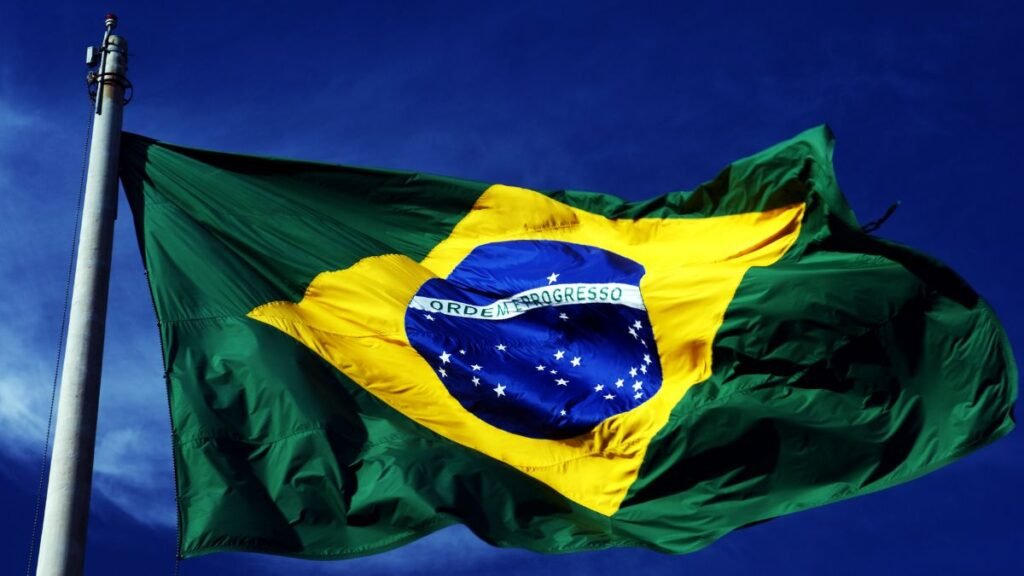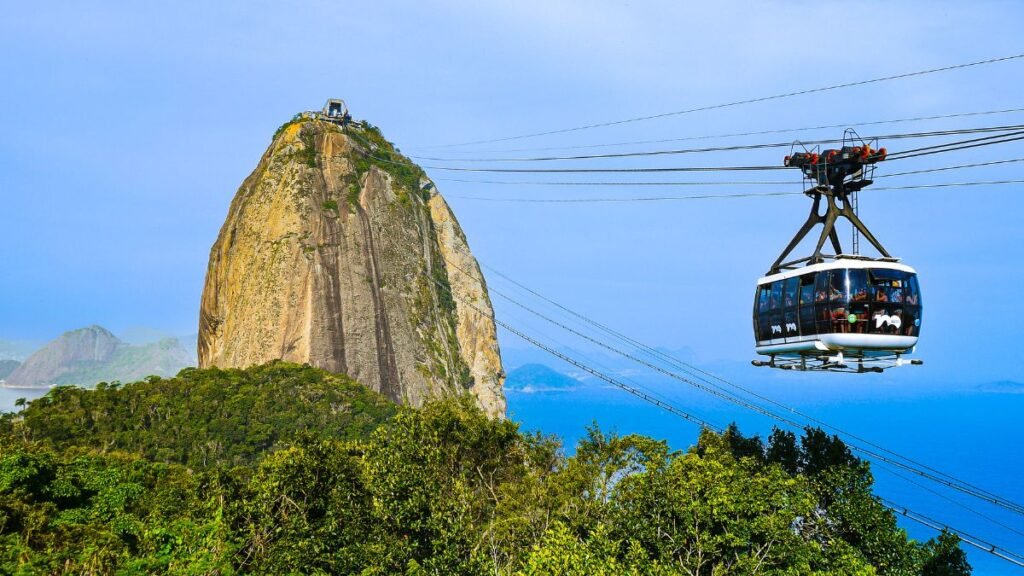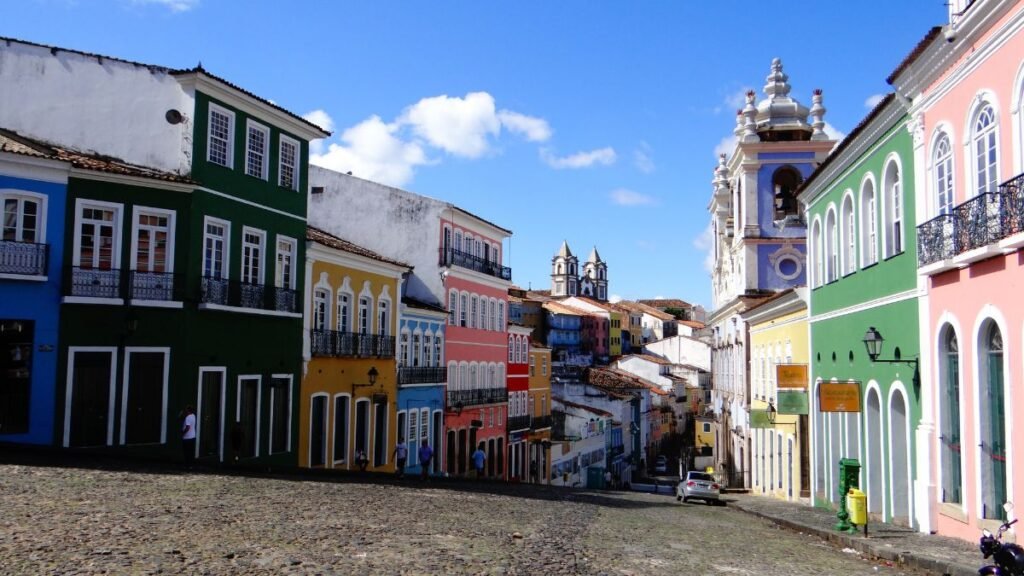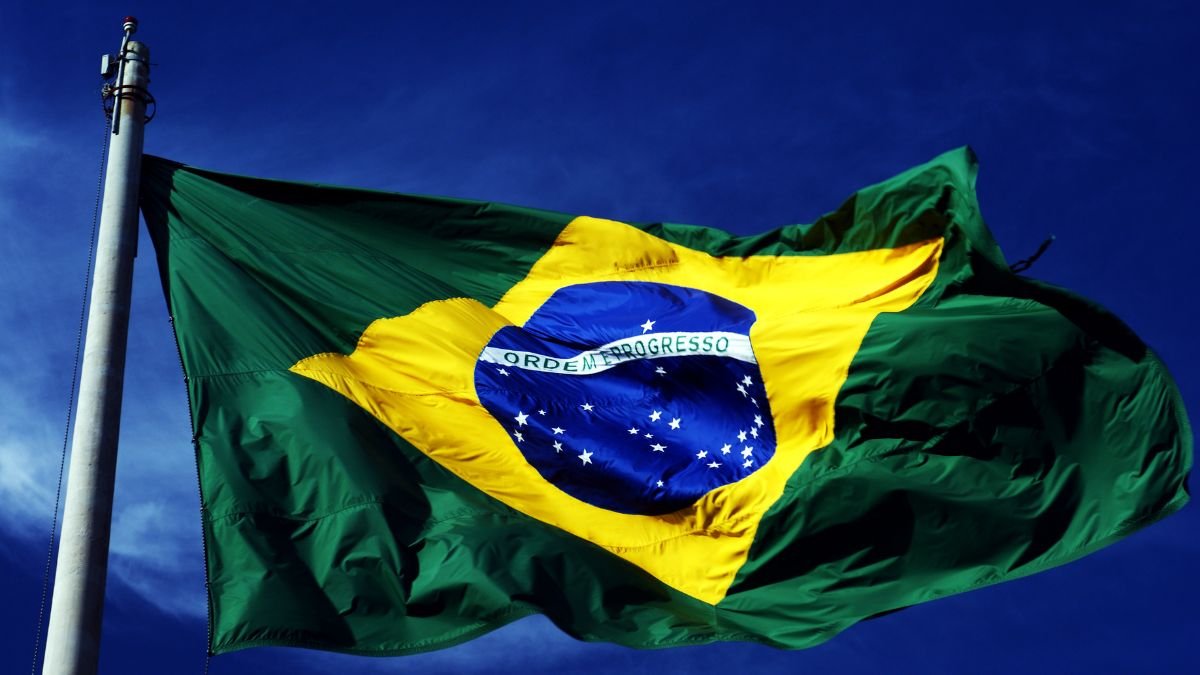Introduction
Brazilian culture is more than beaches and football – it’s layered, surprising, and deeply rooted in history. From its Indigenous roots to African and European influences, it reflects a rich, complex identity that continues to evolve.
Did you know that one nation blends Indigenous, African, and European traditions into a vibrant cultural tapestry that defines Brazil culture? This fusion creates a dynamic identity that captivates millions worldwide.

From the towering Christ the Redeemer to the roaring Iguassu Falls, this land boasts UNESCO-recognized marvels that attract attention from all corners of the globe. The iconic Christ the Redeemer statue, standing tall atop Corcovado Mountain, not only symbolizes Brazil but also serves as a beacon of faith and hope for millions.
Meanwhile, the breathtaking Iguassu Falls, one of the largest and most stunning waterfall systems in the world, showcases nature’s power and beauty, drawing adventure seekers and nature lovers alike. This natural wonder is often celebrated in the vibrant spirit of Brazilian carnival, reflecting the joy and energy of the nation.
Its global coffee dominance – producing 28% of the world’s supply – fuels both economy and daily rituals, making coffee an integral part of Brazilian culture. Coffee plantations are not just about production; they are steeped in history and tradition, often passed down through generations, reflecting the dedication and passion of Brazilian farmers. These practices are closely tied to Brazilian traditions and the rich tapestry of Afro-Brazilian culture, including the spiritual practices of candomblé in Brazil.
Recent developments, like the 2025 elephant sanctuary, showcase evolving aspects of Brazilian culture that highlight Brazil’s commitment to wildlife conservation and sustainable tourism. This sanctuary provides a safe haven for elephants while raising awareness about animal welfare and the preservation of biodiversity. If you’re passionate about Brazil’s natural wonders and eco-friendly initiatives, don’t miss our article on Brazil’s breathtaking natural landscapes, where we explore more examples of the country’s environmental richness.
Over a million visitors flock here annually, drawn by rhythms, flavors, and stories that define Brazilian culture found nowhere else, from vibrant festivals celebrating Afro-Brazilian heritage to diverse culinary experiences that blend indigenous ingredients with global influences. Each visitor leaves with a deeper appreciation for Brazil’s rich cultural landscape and its ability to unite people through shared experiences.
Key Takeaways
- Blends Indigenous, African, and European influences uniquely
- Hosts UNESCO sites like Iguassu Falls and Christ the Redeemer
- Leads global coffee production with 28% market share
- Introduces modern projects like elephant sanctuaries
- Attracts over 1 million cultural tourists yearly, eager to experience Brazilian Traditions
1. A Melting Pot of Influences: The Roots of Brazil Culture
Few places on earth reflect such a vivid fusion of ancestral legacies as this South American gem. Over centuries, interactions between indigenous people, African communities, and European settlers created a society where traditions evolve yet endure.
This intricate tapestry of cultures has resulted in a vibrant mix of languages, music, and culinary practices that define Brazil today. Indigenous tribes, such as the Guarani and Tupinambá, contributed not only their languages but also their deep connection to the land, which continues to influence environmental stewardship.
African communities brought rich spiritual traditions and artistic expressions, particularly in music and dance, which are celebrated in festivals across the nation as part of the vibrant Brazilian Traditions. European settlers, particularly the Portuguese, infused their customs and governance structures, further shaping the cultural landscape. Together, these diverse influences create a dynamic society that thrives on the interplay of its varied roots.
Indigenous, African, and European Legacies
The Tupí-Guaraní language left an indelible mark on the cultural landscape of Brazil. Words like “abacaxi” (pineapple) and “mandioca” (cassava) still pepper daily speech, illustrating the profound impact of indigenous languages on modern Portuguese.
This linguistic heritage serves as a reminder of the rich history and traditions of the indigenous peoples, whose contributions extend beyond vocabulary to encompass worldviews and ecological knowledge. “Language carries our history,” notes a linguist studying these influences, emphasizing how these words are not just terms but vessels of cultural identity and memory.
Afro-Brazilian traditions thrive strongest along the coast, representing one of the most powerful roots of Brazilian culture, where the blending of cultures has given rise to vibrant expressions of identity. In Bahia, Candomblé — a religion that merges Yoruba beliefs with Catholicism – honors ancestral spirits through music and dance, showcasing the resilience and creativity of enslaved Africans who preserved their heritage. To understand how these practices continue to shape Brazil’s modern culture, explore our article on Brazilian traditions that define the nation’s spirit.
The rhythmic beats of drums and the colorful garments worn during ceremonies reflect a rich tapestry of history, spirituality, and community, highlighting how these traditions continue to evolve while remaining rooted in their origins.
This syncretism mirrors the resilience of enslaved Africans who preserved their heritage, adapting their practices to survive and flourish in a new land.
How Portuguese Colonization Shaped Modern Society
Portugal’s 16th-century arrival brought sweeping changes. Their language became dominant (spoken by 99% of the population), while Catholic churches replaced indigenous temples. Colonial architecture, like Salvador’s Pelourinho district, still stands today.
Later years saw waves of Italian, German, and Japanese immigrants. Each group added layers, from pasta in São Paulo to tea plantations in Paraná. These cultures didn’t just coexist; they intermarried and reshaped the nation’s identity.
- Amazon Basin: Home to 300+ indigenous groups, preserving ancestral knowledge.
- Northeast: African roots dominate cuisine, music, and festivals.
- Southern Highlands: European traditions flourish in wine country and Oktoberfests.
2. The Heartbeat of Brazil: Music and Dance
Rhythms pulse through every street, telling stories of resilience and joy. This nation’s soundtrack blends African drums, Portuguese guitars, and indigenous chants into unforgettable melodies. From lively street parties to polished concert halls, music and dance are the soul of daily life.
Samba, Bossa Nova, and Beyond
Samba’s roots trace back to Bahian slave communities, where it was born from the blending of African rhythms and Portuguese musical influences. By the 1930s, it became a national symbol, especially in Rio Janeiro’s Carnival, a vibrant celebration that showcases the heart and soul of Brazilian culture.
“Samba is resistance,” says a local musician, emphasizing its role as a voice for the marginalized. Its hypnotic beats now draw millions to parades, where the streets come alive with colorful costumes and joyous dancing, reflecting a deep sense of community and cultural pride.
In the 1950s, Bossa Nova emerged in Rio’s jazz clubs, representing a sophisticated fusion of samba and jazz influences. João Gilberto and Stan Getz turned it global with hits like “The Girl from Ipanema,” which captivated audiences around the world and introduced them to the smooth, laid-back rhythms that defined the genre.
Today, genres like sertanejo (country) and axé (Caribbean fusion) dominate charts, showcasing the ongoing evolution of Brazilian music and its ability to incorporate diverse influences while retaining its unique identity.
The Global Impact of Brazilian Rhythms
Brazilian sounds influence artists worldwide. The 1960s Bossa Nova wave reshaped jazz, while modern DJs sample samba beats. In São Paulo, the Sala São Paulo concert hall, a converted railroad station, boasts acoustics rivaling Vienna’s.
- Samba Schools: Community groups preserving Carnival traditions.
- Tropicalismo Revival: 2025 sees artists blending rock, folk, and electronic beats.
- Axé Power: Salvador’s street parties fuse African rhythms with pop.
3. Carnival: The Ultimate Cultural Spectacle
Nowhere else does celebration reach such dazzling heights as during this annual spectacle. For weeks, cities explode with music, dance, and costumes that blur the line between fantasy and reality.
The air fills with the scent of street food, and the sounds of laughter and rhythm echo through the streets, creating an atmosphere of joy and unity among diverse groups of people. Each neighborhood showcases its own unique traditions, contributing to the vibrant tapestry of Carnival.
Rio’s Samba Parades vs. Salvador’s Axé Celebrations
Rio’s Sambadrome dazzles 70,000 spectators with $10M samba school productions. Each float tells a story, from Amazon myths to space odysseys, capturing the imagination of all who witness them.
These grand displays are not just performances; they are a celebration of Brazilian culture and history, with each samba school dedicating months of preparation to create stunning visual spectacles. *”It’s Broadway meets Mardi Gras,”* says a veteran choreographer, emphasizing the artistic and theatrical elements that make these parades unforgettable.
Salvador’s trios elétricos (massive mobile stages) rule for 25 days, bringing music directly to the people. Crowds follow them through streets, dancing to axé beats that energize the atmosphere. Unlike Rio’s ticketed event, here, everyone joins the party, regardless of background or social status, creating a sense of community and shared celebration. The spontaneity of Salvador’s festivities allows for a more intimate experience, where locals and visitors alike can participate in the joyous revelry.
Carnival’s Historical and Religious Significance
The festival’s timing ties to Catholic Lent, but its roots run deeper. Enslaved Africans blended their religion (Candomblé) with European masquerades, creating entrudo, a playful street battle with water and flour that reflects a rich history of resistance and resilience.
This fusion of cultures is a testament to the enduring spirit of the Brazilian people and Brazilian traditions, showcasing how traditions evolve while retaining their essence.
Today, Bahian costumes honor people’s spiritual heritage. Feather headdresses mirror Yoruba deities, while drum patterns echo ancestral prayers, reminding participants of their roots and the significance of their heritage.
Even the time aligns with pre-Lenten agricultural cycles, highlighting the connection between Carnival and the rhythms of nature, as communities celebrate the bounty of the earth.
- Safety first: 2025 introduces AI surveillance to curb pickpocketing in crowded areas, ensuring that revelers can enjoy the festivities without fear.
- São Paulo’s rise is unmistakable: its LGBT+ Carnival blocos now rival Rio’s in glamour, becoming a symbol of inclusion within Brazilian cultural expressions, celebrating the diversity and inclusivity that define modern Carnival. To discover how this iconic festival reflects Brazil’s cultural identity across regions, check out our article on Brazilian Carnival traditions and how they continue to evolve.
- Global draw Visitors spend $1.2B annually, boosting local economies and fostering cultural exchange as tourists flock to experience this unique celebration.
4. Brazil’s Beach Life Phenomenon
Sandy shores serve as the nation’s living room, where social classes blur under the sun. Over 85% of the population lives within three hours of the coast, making beaches inseparable from daily life.

Copacabana and Beyond: Coastal Traditions
In Rio Janeiro, urban beaches like Copacabana buzz with volleyball games and juice vendors. The iconic “posto” system, numbered lifeguard towers, organizes the shore into sections for sports, parties, and family gatherings.
Meanwhile, fishing villages in Bahia’s regions preserve quieter rituals. Nets dry on sand while locals grill fresh moqueca (fish stew) over open fires. These contrasts reveal a coastline where modernity and tradition coexist.
| Feature | Urban Beaches (Rio) | Fishing Villages (Bahia) |
|---|---|---|
| Activities | Beach soccer, fitness classes | Boat repairs, fish markets |
| Social Role | Weekend party hub | Daily livelihood center |
| 2025 Initiatives | Solar-powered “posto” towers | Eco-tourism cooperatives |
Why Beaches Are Social Hubs
From CEOs to street vendors, everyone shares the same sand. “The beach is our democracy,” says a Rio sociologist. Even luxury high-rises like Copacabana Palace (now renovating) can’t fence off the shore.
New Year’s Eve proves this unity best. Two million revelers dress in white to honor Yemanjá, the sea goddess, while fireworks light up the sky. It’s a ritual that transcends wealth, age, and background.
5. Family, Food, and Hospitality
Food tells stories here, every dish carries centuries of history and heart. Meals are more than sustenance; they’re acts of love, woven into daily life. From bustling city kitchens to quiet coastal homes, recipes bridge generations and geographies.
Feijoada and Other Iconic Dishes
Enslaved people transformed scraps into feijoada, now the country’s national dish. Black beans simmer with pork cuts for hours, served with orange slices and farofa. *”It’s a dish of resilience,”* says chef Rodrigo Oliveira.
Brigadeiros, chocolate truffles, dominate celebrations, with 2 billion consumed yearly. Regional stars like Bahia’s acarajé (black-eyed pea fritters) showcase Africa’s culinary legacy. For deeper dives, explore traditional Brazilian food guides.
The Art of Brazilian Home Cooking
Maria Lucia Magalhães’ 50-year kitchen legacy proves meals bond family. Her clay-pot moqueca,layered with coconut milk and dendê oil, follows ancestral techniques. *”Time slows down here,”* she notes, stirring slowly over flames.
Modern shifts emerge: 30% avoid alcohol for religious reasons. Gifting etiquette matters, avoid purple flowers (associated with mourning), but wine works if hosts drink. The language of hospitality? Always seconds on dessert.
- Feijoada Wednesdays: Many restaurants reserve midweek for this hearty staple.
- Clay-Pot Revival: Artisans report 20% sales uptick as millennials rediscover slow cooking.
- Barreado Secrets: Paraná’s meat stew cooks underground for 12 hours—a time-honored trick.
6. Religion’s Role in Shaping Brazil Culture
Faith weaves through daily life here, shaping traditions from street festivals to sacred rituals. Over 64% identify as Catholic, while 22% follow Protestant teachings. Yet beneath these numbers lies a vibrant spiritual mosaic.

From Catholicism to Candomblé
The 18th-century Jesuit churches of Minas Gerais showcase baroque gold leaf altars. These UNESCO sites reveal how religion fueled art. Meanwhile, Bahia’s Candomblé temples honor Yoruba indigenous people’s orixás (deities) through drum ceremonies.
Aparecida Basilica draws 12 million pilgrims yearly. Many walk 62 miles from São Paulo, following routes mapped since the 1700s. In 2025, Christ the Redeemer will host Jubilee Year events, blending modern tech with ancient rites.
Festivals with Spiritual Roots
Festa do Bonfim ties Catholic saints to African spirits. Devotees wash church steps with scented water—a ritual born from enslaved people’s resistance. “Our festivals are prayers in motion,” explains a Salvador priest.
Pentecostal churches now thrive in favelas, offering social services alongside worship. Their growth reflects how religion adapts to urban needs while preserving core beliefs.
| Tradition | Location | Key Feature |
|---|---|---|
| Catholic Pilgrimages | Aparecida | 12M annual visitors |
| Candomblé Ceremonies | Bahia | Yoruba drum rituals |
| Pentecostal Services | Rio favelas | 35% growth since 2020 |
7. Indigenous Heritage and Modern Brazil
Ancient wisdom meets modern innovation in the heart of South America. Over 180 indigenous languages still thrive, spoken by 40,000+ people. These tongues, like Tupí-Guaraní, shape the country’s Portuguese syntax, proof that history lives in everyday speech.
Surviving Languages and Traditions
The Memorial of Indigenous People in Brasília documents 120 lost languages. Yet, tribes like the Suruí harness technology, using Google Earth to monitor deforestation. “Our words guard the forest,” says a Suruí elder.
In 2025, the Supreme Court will rule on Yanomami land rights, a landmark case for 30,000 tribal members. Their struggle reflects a broader clash between tradition and progress.
How Indigenous Art Influences Contemporary Design
Marajoara pottery, a 1,000-year-old craft, now inspires Hermès collections. Meanwhile, Oscar Niemeyer’s Brasília designs echo Amazonian curves. “Nature’s forms are timeless,” notes a curator at Museu de Arte Indígena.
- Global Collaborations: Suruí leaders partner with Silicon Valley to map ancestral lands.
- Fashion Fusion: Designers blend Kayapó beadwork with haute couture.
- Legal Milestones: The 2025 Yanomami verdict could redefine land rights worldwide.
Conclusion: Why Brazil’s Culture Captivates the World
From the towering Christ the Redeemer to the roaring Iguassu Falls, this land boasts UNESCO-recognized marvels that attract attention from all corners of the globe. The iconic Christ the Redeemer statue, standing tall atop Corcovado Mountain, not only symbolizes Brazil but also serves as a beacon of faith and hope for millions.
Meanwhile, the breathtaking Iguassu Falls, one of the largest and most stunning waterfall systems in the world, showcases nature’s power and beauty, drawing adventure seekers and nature lovers alike. This natural wonder is often celebrated in the vibrant spirit of Brazilian carnival, reflecting the joy and energy of the nation.
Its global coffee dominance – producing 28% of the world’s supply – fuels both economy and daily rituals, making coffee an integral part of Brazilian culture. Coffee plantations are not just about production; they are steeped in history and tradition, often passed down through generations, reflecting the dedication and passion of Brazilian farmers. These practices are closely tied to Brazilian traditions and the rich tapestry of Afro-Brazilian culture, including the spiritual practices of candomblé in Brazil.
FAQ
What makes Brazilian culture unique?
The nation blends indigenous, African, and European traditions, creating vibrant music, food, and festivals like Carnival. Its diversity sets it apart globally.
How did Portuguese colonization influence modern Brazil?
Portugal introduced the language, Catholicism, and architectural styles, while African and indigenous elements enriched art, cuisine, and spiritual practices.
Why is samba so important in Brazil?
Born in Rio’s Afro-Brazilian communities, samba symbolizes resistance and joy. It’s central to Carnival and a source of national pride.
What’s the difference between Rio and Salvador’s Carnival celebrations?
Rio features elaborate samba parades, while Salvador’s street parties highlight axé music. Both reflect regional history and African roots.
How do beaches shape social life in Brazil?
Coastal spots like Copacabana are gathering places for sports, music, and open-air dining, reflecting the country’s love for outdoor living
What role does religion play in daily life?
Catholicism coexists with Afro-Brazilian faiths like Candomblé. Festivals often merge spiritual rituals with public celebrations.
Are indigenous traditions still present today?
Yes. Tribes preserve languages, crafts, and eco-friendly practices, while their art inspires modern fashion and design.




